
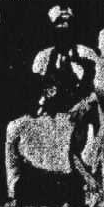
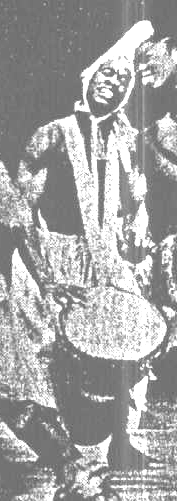
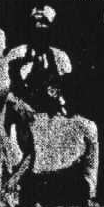

"Ballets Africains
de la
République de Guinée"Brochure for the world-tour in 1965-1967
In which the mask dance Kakilambe' is described.
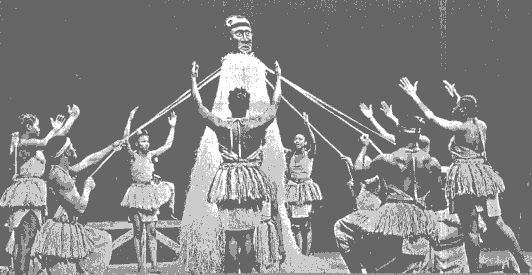
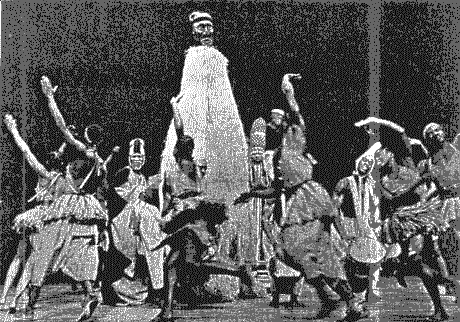
Aux sans hypnotiques des tam-tams, les danses atteignent leur paroxysme -
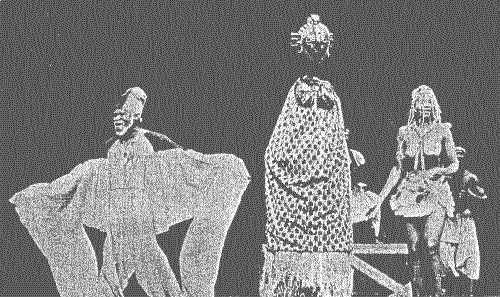
L'èvocation sensible d'un culte naguère idiolatrè - (Faouly CAMARA et Fanta KABA autour du Nimba)
La frènèsie de la musique emporte les danseurs dans des èvolutions fantastiques.
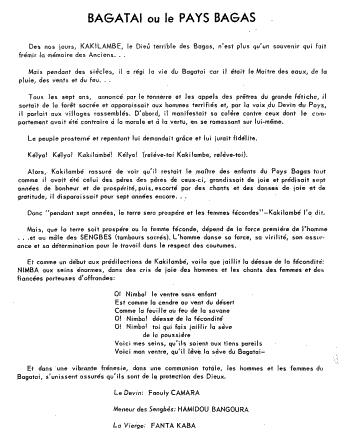
French Text
BAGATAI ou le PAYS BAGAS
Des nos jours, KAKILAMBE, le dieu' terrible des Bagas, n'est plus qu'un souvenir qui fait frèmir la mèmoire des Anciens...Mais pendant des siècles, il a règi la vie du Bagatai car il ètait le Maitre des eaux, de la pluie, des vents et du feu...
Tous les sept ans, annoncè par le tonnerre et les appels des prètres du grande fètiche, il sortait de la forèt sacrèe et apparaissait aux hommes terrifiès et, par la voix du Devin du Pays, il parlait aux villages rassemblès. D'abord, il manifestait sa colère contre ceux dont le comportement avait ètè contraire a' la morale et a' la vertu, en se ramassant sur lui-mème.
Le peuple prosternè et repentant lui demandait gra'ce et lui jurait fidèlite.
Alors, Kakilambè rassurè de voir qu'il restait le maitre des enfants du Pays Bagas tout comme il avait ètè celui des pères des pères de ceux-ci, grandissait de joie et prèdisait sept annèes de bonheur et de prospèritè , puis, escortè par des chants et des danses de joie et de gratitude, il disparaissait pour sept annèes encore...
Donc "pendant sept annèes, la terre sera prospère et les femmes fècondes" - Kakilambè la dit.
Mais, que la terre soit prospère ou la femme fèconde, dèpend de la force première de l'homme ...et au male des Sengbes (tambors sacrès). L'homme danse sa force, sa virilitè, son assurance et sa dètermination pour le travail dans le respect des coutumes.
Et comme un dèbut aux prèdilections de Kakilambè, voila que jaillit la dèesse de la fèconditè: Nimba aux seins ènormes, dans des cris de joie des hommes et les chants des femmes et des fiancèes porteuses d'offrandes:
O! Nimba! le ventre sans enfront
Est comme la cendre au vent du dèsert
Comme la feuille au feu de la savane
O! Nimba! dèesse de la fèconditè
O! Nimba! toi qui fais jaillir la sève de la poussière
Voici mes seins, qu'ils soient aux tiens pareils
Voici mon ventre, qu'il lève la seve du Bagatai-Et dans une vibrante frènesie, dans une communion totale, les hommes et les femmes du Bagatai, s'unissent assurès qu'ils sont de la protection des Dieux.
English Text kindly translated for Signa PHI Nothing by Max van Pelt
BAGATAI or the Land of the BAGAS
Nowadays Kakilambè the terrible god of the Bagas is no more than a memory that makes the recollection of the Elders shake, but for many centuries Kakilambè ruled life of the Bagatai, because he was the Master of the waters, the rain, the wind and the fire. Every seven years, announced by the thunder and the calls of the priests of the great fetish, Kakilambè came out of the holy forest and appeared to the terrified people and, through the voice of the Holy man of the Land, he spoke to the assembled villagers. At first he manifested his anger against all those whose comportment was against the morals and the virtue, [which he gathers on?] himself. The people would prostrate themselves in repentance and beg for his blessing and swearing their fidelity. Thus, Kailambè was reassured and would see that he still remains the master of the children of the Land of the Bagas, just like he had been the master of the fathers of their fathers. He (Kakilambè) grew (swelled?) with joy and predicted seven years of good luck and prosperity. Then escorted by songs and dances of joy and gratitude he disappeared for another seven years. And thus "during seven years the earth shall prosper and the women shall be fertile" for Kakilambè says so. However, that the earth should prosper and the women be fertile, depends on the primary power of the man and from the [masculinity? maleness? male beat? rhythm?] of the Sengbes (Djembés?). The man dances his power, his virility, his assurance (certainty, self-assuredness) and his determination in doing the work in respect of the traditions (or alternatively, the determination to uphold the traditions). And like a beginning to the predelictions (or alternatively, a beginning to what Kakilambè stands for) of Kakilambè, here bursts forth (springs up, soars up suddenly) the goddess of fertility: Nimba with the enormous breasts, in the middle of the cries of joy from the men and the songs of the women and the fianceés (those who are engaged to be married) who are also bringers of offerings.O Nimba! the belly [without?] the belly that bears no [fruit?]
Is like the ashes in the wind of the desert,
Or like the leaf in the fire of the savanna!
O Nimba goddess of fertility!
O Nimba you who make sprouts spring forth from the dust!
Here are my breasts may they be like yours,
Here is my belly that it may grow the sprout of the Bagatai!And in a vibrant, frenetic, total communion, the men and women of the Bagatai, unite (join) together, assured that they are under the protection of the Gods.
Additional commentary is provided from Max van Pelt to his translation of the text (and pictures) above by his friend, Onno van Tongeren, a Djembé teacher from Rotterdam and expert on West Africa with apparently much knowledge about Kakilambé and recent history in Guinée.
Max van Pelt provides the original Dutch from Onno van Tongeren (italicized) with Max's translation (BOLD) of the commentary.
Het masker Kakilambè is van oorsprong het belangrijkste mannelijke masker van de Baga-Sitému, in de noordelijke kuststreek van Guinée.The mask Kakilambè originally is the most important mask of the Baga-Sitému, in the northern coastal region of Guinée.
De originele Baga-naam van dit masker is "A-Mantsho-Ngo-Pon" (De grote "Mantsho", waarbij Mantsho waarschijnlijk staat voor "chief" of "koning".
The original Baga-name of this mask is "A-Mantsho-Ngo-Pon" ("The Great Mantsho," in which Mantsho probably stands for "Chief" or "King").
Andere namen voor hetzelfde masker zijn "Äparan" (grootvader)of "Wu-Them" (de oude man).
Additional names for this same mask are Ärapan" (grandfather) or "Wu-Them" (the old man).
Het masker stond ook wel bekend onder de eigennamen "Somtup" en "Boglansh".
The mask was also referred to by the first names "Somtup"and "Boglansh."
De Susu noemen dit masker Kakilambè (zo hoog als de Kaki-boom), omdat dit masker naar verluidt zeer hoog was (volgens verschillende bronnen variërend van zeven tot twintig meters !)
The Susu call this mask Kakilambè (as high as the Kaki-tree) because people say this mask was very tall (according to various sources varying between seven and twenty meters)!
Dit masker bestond uit een met rafia omkleedde basis met daarop de kop van een vogel, en werd gedragen door een grote groep mannen die onder de rafia bekleding schuil gingen.
The mask consisted of a base clad in raffia with the head of a bird on top of that and was carried by a large group of men that walked hidden under the raffia.
Vanaf de top van het masker liepen lange koorden die ervoor dienden om het masker recht te houden.
From the top of the mask long ropes led which served the purpose of holding the mask upright.
Het masker mocht niet vallen anders zou dat ongeluk in plaats van voorspoed brengen.
It was imperative that the mask should not fall because that would bring bad luck instead of prosperity.
Het Kakilambè-masker kwam hooguit eens per jaar te voorschijn (sommigen zeggen om de zeven of zelfs om de tien jaar) en mocht alleen aanschouwd worden door in de geheimen van het masker ingewijde personen.
The Kakilambè mask was only brought forth at the most one time a year (some say once every seven or even 10 years) and was only allowed to be observed by those initiated in the secrets of this mask.
Tot zover het originele masker (voor een ieder die één en ander nog wil nalezen leze het boek "Art of the Baga" van Dr. Frederick Lamp een authoriteit op het gebied van de Baga-maskers. Er is een exemplaar aanwezig in de bibliotheek van het Volkenkundig Museum te Rotterdam, maar ik denk dat het ook te vinden zal zijn in het Tropenistituut. In het boek bevindt zich ook een afbeelding van het Kakilambè-masker)
For those interested in reading about the original mask please see: "The Art of the Baga" by Dr. Frederick Lamp, an authority on Baga masks. In the Rotterdam library of the Anthropological Museum there is a copy, and I think also the Amsterdam Tropeninstituut will probably have a copy. In the book there is also a picture of the Kakilambè mask.)
De verwarring omtrent het Kakilambè-masker is ontstaan in de jaren zestig.
The confusion around the Kailambé-mask originated in the sixties.
De Comunistische dictator Sèkou Touré begon toen zijn eigen versie van de Culturele Revolutie ("Le Programme de Démystification"), met de bedoeling om alle traditionele religies te ontmaskeren.
The communist dictator Ahmed Sèkou Touré began his own version of the Cultural Revolution ("The Demystification Program") with the intention to unmask all the traditional religions.
Eén van de manieren hierbij was om de geheime maskers te roven en vervolgens in het openbaar op het podium te brengen.
One of the ways in this program was to steal the secret masks and successively publicly expose them on stage.
Het probleem bij het Kakilambè-masker was dat dit masker al in de jaren vijftig was verdwenen tijdens de Jihad van moslimleider Asekou Sayon.
The problem with the Kakilambè mask was that this mask had already disappeared in the fifties, during the Jihad of Muslim leader Asekou Sayon [(Malinké) with Asekou Bokari (Susu)].
Asekou Sayon maakte bij zijn Jihad dankbaar gebruik van het feit dat de oude Baga-beschaving een Gerontocratie was (bestuur door stamoudsten).
Asekou Sayon made opportunistic use in his Jihad of the fact that the old Baga civilisation was a gerontocracy (rule by elders of the tribe).
Hij hitste de jongeren tegen de ouderen op, en die confisceerden op hun beurt de maskers van de stamoudsten.
He incited the young Baga against the elders and they confiscated the masks from the tribe-elders.
Die maskers werden vervolgens voor veel geld aan Franse kunstverzamelaars en musea.
Next they sold the masks for great sums of money to French art collectors and museums.
Tegen de tijd datverkocht en daarmee financiëerde Asekou zijn Jihad.
With the thus acquired funds Asekou financed his Jihad.
De Jihad de noordelijke Baga-gebieden naderden waren de stamoudsten al gewaarschud en zij verborgen daarop de maskers van Kakilambè en "Abol"(de vrouw van Kakilambè).
By the time the Jihad reached the northern territories the Baga-elders were forewarned and they hid the masks of Kakilambè and "Abol" (the wife of Kakilambè)
De ritmes die het Kakilambè-masker begeleidden bleven behouden, en deze werden in de jaren zestig voor het eest op het podium gepresenteerd door het "Ballet de Conakry II".
The rhythms that accompany the Kakilambè mask were conserved and in the sixties they were first presented on stage by the "Ballet of Conakry II."
Omdat het originele masker niet meer bestond deed men dit met een eigen versie: "Le-Kakilambè-sur-scène" (De Kakilambè op het podium) zijnde een gemaskerde stelt-danser.
Because the original mask no longer existed this was done using their own version: "The Kailambé-on-stage" being a masked stilt walker.
Een versie die tot op heden nog bestaat.
This version exists unto this day.
Ik heb dit masker zelf gezien en het werd gedanst door één van de zonen van "Le vieux Coca", maskermaker, oud-artiest en famillie van Fodé Youla (Africa Djolé), die het Kakilambè-ritme in Europa populair maakte.
I have seen this mask myself and it was danced by one of the sons of "the Old Coca", mask-maker, former artist and related to Fodé Youla (from Africa Djolé) who made the Kakilambè rhythm popular in Europe.
Op het internet circuleren regelmatig afbeeldingen van een Kakilambe-masker van "Les Ballets Aricaines de Guinée".
On the Internet there are regularly circulating pictures of a Kakilambè mask from "The African Ballets of Guinée."
De preciese herkomst van dit masker heb ik tot op heden nog niet kunnen achterhalen, maar ik heb wel een vermoeden.
The precise origin of this mask I have so far not been able to find, but I do have a hunch.
Het lijkt namelijk sterk op een mannelijke versie van het masker "Sosornet".
It resembles strongly a male version of the mask "Sorsonet."
Sosornet staat ook bekend als de "Kakilambè-des Jeunes"(de Kakilambè van de jongeren), en was dus altijd al het bezit van de jongeren.
Sosornet is also known as the "Kailambé of Youth" (The Kakilambè of the young people) and so was always in the possession of the young people.
In de filosofie van de Baga staat ouder voor mannelijk en jonger voor vrouwelijk.
In the philosophy of the Baga, "older" stands for male and "younger" stands for female.
Het lijkt er dus op dat de jongeren het originele Kakilambè-masker hebben willen reconstrueren door een mannelijke versie van hun eigen (vrouwelijke) masker te maken.
It appears that the younger have wanted to reconstruct the original Kakilambè mask by constructing a male version of their own (female) mask.
Ik denk dat dit ook het masker is waar Mamady Keita (geen Baga, maar Malinke, en groot geworden in het ballet) over spreekt.
I think that this also is the mask about which Mamady Keïta (who is not a Baga but is Malinké and raised in the Ballet) speaks.
Literary and Graphical Freeware: Not for Commercial Use.
Copyright (c) 1998-2011 R. Clark - clark@acceleration.net .
Permission is granted to make and distribute verbatim copies of this publication (www.acceleration.net/clark and all children) provided the copyright notice and this permission notice are preserved on all copies.

